Sound, speed, rust and re-cycling
Jon Rose: Canberra 100, The Canberra Pursuit
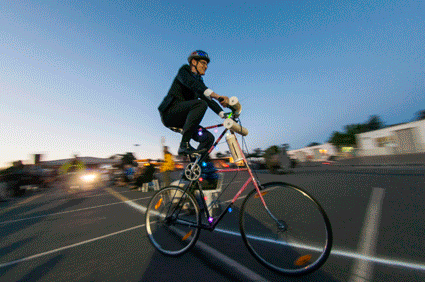
The Canberra Pursuit, Jon Rose and collaborators, Canberra100
photos Martin Ollman
The Canberra Pursuit, Jon Rose and collaborators, Canberra100
As part of Canberra’s Centenary celebrations, Jon Rose has presented the largest version to date of his Pursuit project, modifying over 130 bikes to become musical instruments. Below he offers a personal account of this unique art venture that combines experimental music, sculpture, community creativity, ecological responsibility and, of course, fitness. [Eds]
According to The Australian Bicycle Council, Canberra comes out way on top compared to the national average on most statistics to do with bicycle ownership, work and pleasure use, participation by gender and number of bikes per household. So, from an organisational perspective, Pursuit was a perfect match for a town that has always considered the bike in its planning priorities. As Pursuit was being built at TAMS (basically the transport services depot for Canberra), a new bike lane was under construction right outside the front gate—in an industrial zone (unthinkable in Sydney). The site itself was huge and included a large ‘hangar’ space and car park in our operational zone.
I thought we would be stretched to present 80 musical bikes for Pursuit; we ended up with an astonishing 130 in the event, from the very simple (foot pumps attached to pedal powered whistles), to quite complex machines (a piano tuned to an F major chord and played by two independent ‘hands’ adjusted in range, pitch inversion and rhythm by the position of the handlebars). By chance, the last instrument made for the previous Pursuit (at Mona Foma 2010).) became the model mechanism for a number of instruments in the Canberra Pursuit—light, robust, comparatively easy to assemble, minimal welding and spoke driven—we named it The Tickler. And tickle it did, via a host of different resonating objects from oil drums to metal plates and wooden boxes.
The main instrument makers were Wayne Kotzur, Paul Bryant and me. To this central production team came significant members of The Rat Patrol, the Melba Copeland Chopper program, Jim Sharrock, the outstanding Bell Chamberlain—about 25 makers in total. An attempt to integrate the local Make Hack Void into building a wide-ranging re-cycled electronic junk component for Pursuit went off the boil; the exception was Adam Thomas, who re-cycled an old Atari. Included in The Canberra edition of Pursuit were a few instruments from earlier manifestations of the project, including the original Viocycle with gearing designed by Paul Bryant (first experienced at The Sydney Velodrome in 2004) and Rod Cooper’s excellent ping-pong bass drum (2009).
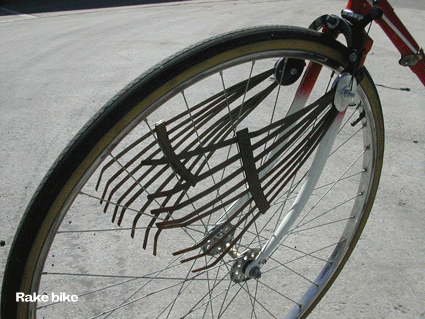
The Canberra Pursuit bikes made by Wayne Kotzur, Paul Bryant and Jon Rose, with extra contributions from Richard Johnson, Bel Chamberlain, Sam King, Harry Vatiliotis
photos Jon Rose
The Canberra Pursuit bikes made by Wayne Kotzur, Paul Bryant and Jon Rose, with extra contributions from Richard Johnson, Bel Chamberlain, Sam King, Harry Vatiliotis
New music species
The musical bikes of Pursuit can be divided up into six classes of homemade instrument making:
1. regular musical instruments played by the cyclic mechanism of a moving bike, eg viola or guitar;
2. artefacts not normally associated with music performance which were sonified by bike action, eg a baking tray, a polystyrene vegetable box, dragged and ‘flapperphoned’ drainage pipes, reversing truck bleepers, forty-gallon drums, a water bottle amplified clicker, a fire extinguisher, typewriters (it was Canberra’s birthday!) or a siren (despite Edgar Varèse, this perfect glissando of an instrument remains exotic in orchestral music);
3. constructed extensions to bike mechanisms that manipulate or interfere with the basic repeating cycle of motion, eg a bike fitted with a tennis racket hitting syncopated and timbrally varied strokes with a golf ball into a plywood net;
4. musical instruments uniquely designed and made to function with a moving bike, eg The Grand Fiddle or the Ping Pong bass drum;
5. sonic phenomena induced by stationary exercise bikes, eg the Plectraphone or the Double Violin (2VC);
6. psychoacoustic disturbances intensified by visual and physical bike action, eg the double hammer bike built by Wayne Kotzur—an existentialist statement if ever there was one.
Unlike digital loops, the repetition of bicycle-powered instruments, although cyclic, are not exact copies of previous sonic events. Every cycle of sound reveals sonic transformation, shifts, sometimes subtle, sometimes radical—the most radical being when the mechanism screws up. The use of re-cycled and unreliable materials creates a natural tension; no one can predict if the instrument will last years, days, or minutes.
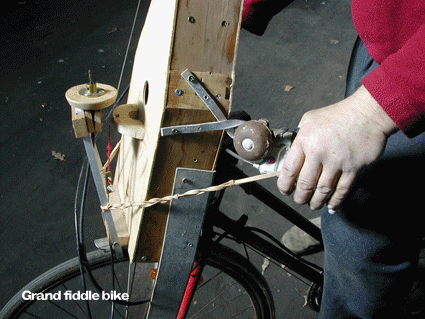
The Canberra Pursuit bikes made by Wayne Kotzur, Paul Bryant and Jon Rose, with extra contributions from Richard Johnson, Bel Chamberlain, Sam King, Harry Vatiliotis
photos Jon Rose
The Canberra Pursuit bikes made by Wayne Kotzur, Paul Bryant and Jon Rose, with extra contributions from Richard Johnson, Bel Chamberlain, Sam King, Harry Vatiliotis
Participatory pedal power
I had originally been encouraged by Dan Watters (the key figure in The Rat Patrol) to believe that several hundred riders would be easily persuaded to take part in Pursuit. In the end, it was hard work finding 50 riders who were keen and engaged in the possibilities of making music through re-cycled bike technology. The gap between serious bike riders, feral cyclists, bike collectors, sculptors, student musicians, casual cyclists and electronic hobbyists remained problematical, despite my efforts to bring the various groups together. Both Dan and I spent much time trying to encourage commitment to Pursuit on a local Canberra level with mixed success. However, I don’t think we could have coped with any more riders on the actual performance night as the last 10 minutes of the spectacle pretty well filled up the track; any more would have constituted a safety hazard.
Talking of which—there were, as predicted, no safety issues despite many bikes having only one brake (the other brake often engaged in musical manipulation such as pitch and rhythm variants) and operating way beyond ‘manufacturer’s specification.’ All bikes and riders returned from the track without incident in both the rehearsal night and the public performance itself. Public Liability insurance was forced on me, but wouldn’t have been worth the paper it was printed on in the event of a claim. It would have been difficult to find a bike in our collection of re-cycled junk without rust, a ding or two or evidence of serious neglect (abundant wildlife was also noted).
The contribution by Jeff Thompson at LEAD was exceptional. He lent us 42 bikes for the event, plus spare tyres, tubes, bells etc. With very few exceptions, all the second-hand bikes were returned in their original condition, the mechanical devices stripped or angle grinded off on the following day after the performance. On the Monday before Pursuit took place, Jeff visited the TAMS site with his team of employees, all of whom were mentally or physically disabled. They were without doubt totally excited by the whole project of which they were a part.
Highlight: one of the guys who struggled to keep up with the rest and who appeared devoid of any expression or speech, pointed at one of the bikes. “You want to ride it?” I asked. No reaction, but I assumed the affirmative and helped him on. Suddenly, he burst out with the broadest possible smile as the sounds started to spin and cascade around the space. This was one of the stationary exercise bikes attached to a previously discarded gas cylinder (the section cut instrument sounded like a sped up gamelan orchestra). That guy’s pure elation was a moment hard to beat.
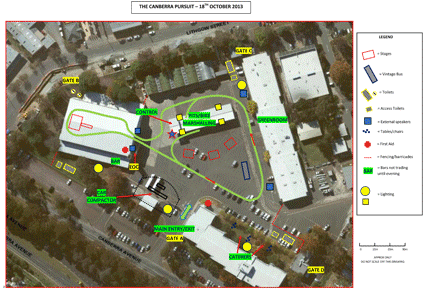
The Canberra Pursuit, route map, Jon Rose and collaborators, Canberra100
photos Martin Ollman
The Canberra Pursuit, route map, Jon Rose and collaborators, Canberra100
Bike & bytes
Combined with the re-cycled and the rusty were two interactive systems. Sam Fergusson wrote and managed the software for the interactive sensor strip that riders cycled over every time they entered ‘The Hangar,’ triggering a selected array of alert sounds, from foghorns to old Apple Macintosh alerts, from car horns and alarm clocks to cockerels. By nature of Pursuit being a community project, I had to consider the possibility that anyone might turn up with a bike on the night and demand to ride; the sensor strip ensured a democratic sonic marker.
Sue Powell (a Paralympic champion cyclist, no less) honoured us by riding her bike (designated the e-bike) fitted with a special box of accelerometers and contact microphones that transmitted bike movements and speed as data to a central computer. This data was then put to use manipulating many aspects of the surround sound audio (which I controlled using my ancient Steim-based software). Video from two live feeds and pre-recorded close up images from over 30 of the musical bikes provided details of how the instruments actually worked. The four riders of The Canberra Bicycle Powered Cinema produced enough DC to power Louise Curham’s appropriate Super 8 film installation, which ran in parallel to the three video screens (two open air, one interior).
They’re racing
The broad structure of The Canberra Pursuit was provided by a time sheet. Every two minutes, on the minute, a new wave of riders hit the track and for three laps proceeded to sound out the space with their specially constructed musical machines (three laps took between 5.20 and 5.50 minutes to complete). Each wave had specific sonic characteristics: for example, a swarm of clicker bikes; a deconstructed drum kit on four bikes (ride cymbal, bass drum, floor tom, tickler snare); Richard Johnson’s trio of reeds and fantastic plumbing bikes; or The Rat’s DJ bike (Master Gravity) where the ruts in the track corresponded to the heavy scratching of a vinyl disc (Queen’s “Bicycle Race”). Some bikes re-constituted themselves for use further into the composition so, the cluster of pedal pumping whistle bikes had their sensitive moving parts removed to render them focused for the bicycle bell episode just prior to the final act.
Since the early 1980s I have been intrigued by the notion that music could be measured as a distance-based expression as much as time based one: not how long is a piece of music, but how far? The wheeling triple necked violin made in 1984 was an attempt at realising this functionality. (http://www.jonroseweb.com/d_picts_wheeling_violin.html)
The track for The Canberra Pursuit came in at 463 meters long, so each performer/bicycle/instrument travelled 1,389 meters in their specific section and since there were 130 machines, we ended up with 180,570 meters of individually defined music plus an unquantifiable distance sonified in the final 10-minute all-in bedlam. The performance lasted one hour. Well, in hindsight there were anomalies, as the piano bike only lasted two laps, the World of Wheels tandem vanished from the pits and at least two of the musical bikes never made the starting grid (these were the feedback handlebar bike and the amplified bowing machine that I had left charging in the storeroom and had completely forgotten about).
On discovery that Bunnings had just taken delivery of their Christmas stock of festive lights and were flogging them at knockdown prices, Dan Watters cleared the store and the visual results as day turned into night around the Pursuit Track were quite stunning for a budget-light show—Catherine Wheels spinning like crazy—and in colour. I hadn’t expected it, but many bikes were turned out in feral finery with feathers, horseshoes, beerbottle tops (the most resplendent and abundant drag Lagerphone ever) and spray cans au-go-go.
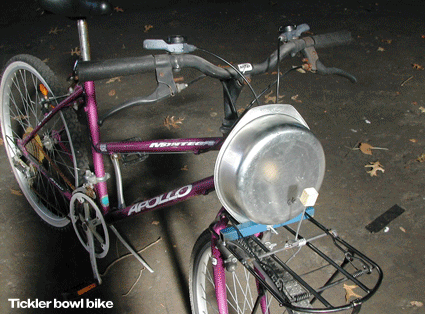
The Canberra Pursuit bikes made by Wayne Kotzur, Paul Bryant and Jon Rose, with extra contributions from Richard Johnson, Bel Chamberlain, Sam King, Harry Vatiliotis
photos Jon Rose
The Canberra Pursuit bikes made by Wayne Kotzur, Paul Bryant and Jon Rose, with extra contributions from Richard Johnson, Bel Chamberlain, Sam King, Harry Vatiliotis
Celebratory new music
It was the legendary Sydney violin maker Harry Vatiliotis who pointed out to me that The Pursuit Project had much in common with the ancient practice of Charivari—the use of noise (rough music or people’s music) for celebration, some sorts of community censure and demonstrations to achieve social, cultural or political change. (A worldwide example of Charivari survives today with the practice of tying tin cans to the back of a car carrying newlyweds surrounded by well wishers energetically hooting their car horns). Pursuit can indeed be considered an example of Charivari, in the sense of both celebration (of Canberra’s birthday) and pointer for ecological revolution, a music practice that demands change in our species behaviour by creating music with trash that celebrates, rather than denies, a sense of place (most music performed in Australia ignores its geographical, cultural and historical context).
By definition, a new musical instrument will tend to produce new music and Pursuit was structured so that, even with fifty acoustic bikes on the track at one time, combined with two systems of amplified interactive sound, each individual bike could be heard as it passed each individual set of ears of an audience member. More often, much smaller constellations could be heard in close focus, in middle distance and amplified through the surround sound up to 100 meters away, all sounds moving at various speeds continuously (except for one stationary ensemble of exercise bikes). Then there were the close up and personal mixes for each cyclist and musical bike, sounds overtaking other sounds along the track, sounds colliding in space.
How much of this became evident to those taking part is a debatable point. Time constraints limited the options of getting to know each musical bike—these instruments were not automatons, they required physical reciprocal operational knowledge. Despite detailed instructions attached to each bike, the musical options of many bikes were likely underutilized, the overall sound world disorientating and fast moving for some, a joyful adrenalin fix for others. Of the 50+ makers and riders involved with Pursuit, only four to my knowledge were bona fide musicians. The experience of Pursuit took place outside the traditional actions and responses of a musician-based performance. I wonder if I’d been able to pay members of a symphony orchestra to take part, whether the musicality would have been better or worse? I’ll leave that question in the air.
Highs & lows & in betweens
High Point: operating two huge surround sound sonic spaces (a ‘Hangar’ and a car park) that were both audible simultaneously. As day turned to night, the other features of mobile sound such as Doppler, phasing, delays and modulations were also audible in the windless Canberra spring evening for those who wanted to hear. Others were there for the social hang (fine by me); when did you last hear members of an audience screaming with delight throughout a new music event?
Low Point: my inability to coax music students from the ANU to get involved with the project. What is it with this generation, the lack of curiosity?
The Point that never ceases to amaze me: how the management of TAMS never stepped up to the mark with a proper professionally painted lined track for the 100th Anniversary and celebration of their town, embarrassing their employees (the guys who do the lines on the roads) and anyone who owes Canberra for a very comfortable living. As a member of the Centennial team remarked, I’ll go to my last days still harbouring that special place of bewilderment in my brain.
Favourite Instrument du Jour: The Ukulele Bike
Pursuit exhibited a large number of professional skills, homemade know how, hands-on knowledge and instrument making techniques and concepts exploring the notion of what constitutes a musical instrument. I don’t know of any other occasion in the musical history of Australia (or anywhere else for that matter) where so many instrumental experiments have been improvised into existence in such a short space of time and returned to their various states of entropy and atrophy immediately post performance—a short lived trajectory like the nature of musical performance itself.
Thanks
Wayne Kotzur and Paul Bryant were key to the success of this project—extra hours, trailer trips, you name it. Special Thanks to Justin Watson, Julian Hobba, Dan Watters (the key link between the world of cycling and the Centenary) for their tolerance and commitment; and to Robyn Archer for taking a risk by providing the original invitation.
Canberra 100: Pursuit 3, concept, composer & director Jon Rose, main instrument makers Paul Bryant & Wayne Kotzur, community engagement Dan Watters; TAMS Depot, Fishwyk, Canberra, 18 Oct; http://www.jonroseweb.com/f_projects_pursuit.html
See also our Archive Highlight compiling our coverage of Jon Rose in RealTime over the years.
Canberra 100: Pursuit 3, concept, composer & director Jon Rose, main instrument makers Paul Bryant & Wayne Kotzur, community engagement Dan Watters; TAMS Depot, Fishwyk, Canberra, 18 Oct; http://www.jonroseweb.com/f_projects_pursuit.html
Links
http://www.youtube.com/watch?v=xpJubsaURps
www.youtube.com/watch?v=0KiGCwJ5b3k
http://www.youtube.com/watch?v=jIwQpzEzIqI
RealTime issue #117 Oct-Nov 2013 pg. web






